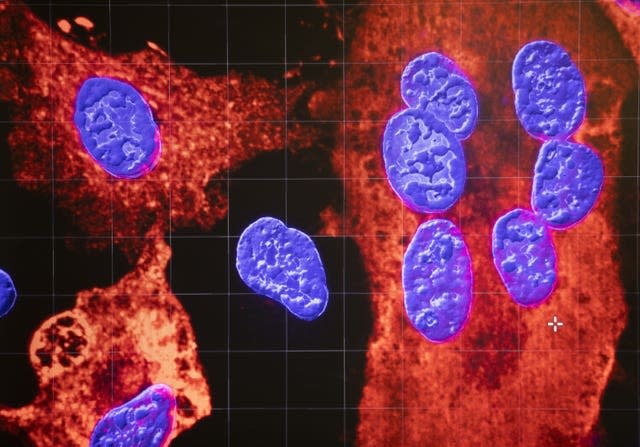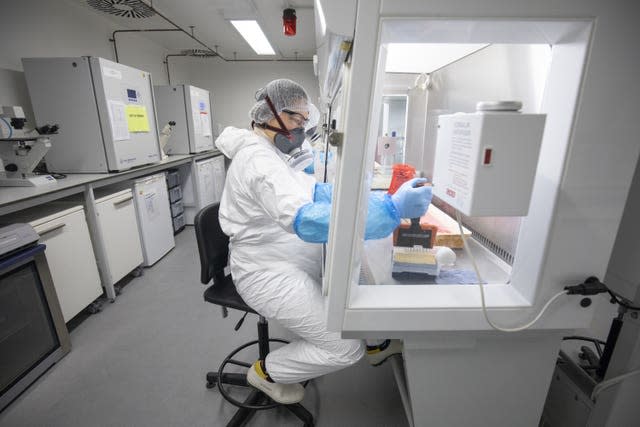Coronavirus surveillance and sequencing ‘must continue for foreseeable future’
Surveillance and genomic sequencing of coronavirus is “going to have to continue for some foreseeable future”, according to experts at a virus research centre in Glasgow.
Last year, the Medical Research Council (MRC)-University of Glasgow Centre for Virus Research (CVR) began focusing some resources into studying SARS-CoV-2 – but every resource was moved to studying the virus once lockdown was implemented.
Now, a year after that first lockdown was introduced, MRC investigator and head of CVR bioinformatics Professor David Robertson has emphasised the importance of continuing surveillance of Covid-19 which has been evolving with a number of variants in the last few months.
He told the PA news agency the extent of change in the virus in a short space of time “took us by surprise”, but has also “shown us the extent of the way the virus can change in the future”.
Prof Robertson said: “The virus for the first 11 months was evolving quite slowly and steadily… at the end of last year there was a real acceleration in the extent of the difference of the variants relative to the first ones to emerge in early 2020.
“We think that’s got a lot to do with the immune profile of the human population changing… now the priority is continuing the monitoring.
“What’s happening now is more people are vaccinated, that’s changed the host environment yet again and the risk then is if you still then have uncontrolled infections in the context of relatively high rates of protection then the virus will evolve to counteract the host immune response.
“It’s really an incredible thing that so many vaccines have been prepared in such a short time and the virus is pushing back against that – that’s kind of how evolution works – so, really, the monitoring, the surveillance, the sequencing, is just going to have to continue for some foreseeable future.
“I guess the biggest change is the intensity of the work has obviously been very timely – in normal circumstances when you’re doing research the data is accumulating and you’re analysing it and it’s not so urgent.
“But clearly with an outbreak like this, and with the UK situation, monitoring the spread of the virus, helping the public health authorities analyse sort of outbreaks and locations… there’s just an urgency that wasn’t there before.”

And while the “UK is very much a lead in the genome sequencing”, he said “one of the biggest challenges actually just being the amount of data and how quickly it’s accumulated” with well over 700,000 genome sequences across the globe.
His comments came as First Minister Nicola Sturgeon recently announced a new £13 million genomic sequencing centre is to be set up in Scotland to identify different variants of coronavirus.
While more details of this are yet to be announced, it may well build on work done at the CVR over the last 12 months.
Professor Massimo Palmarini, CVR director, described the work on variants as “challenging in a lot of ways” but also “rewarding for a scientist”.

He told PA: “I say rewarding because it’s a problem but we invest a lot of time to create the tools and the resources in order to then be able to investigate these.
“For example at the very beginning of the pandemic we knew that we had to generate tools and reagents to work with the virus in the laboratory because the virus didn’t exist before.
“I think now the partnership especially between clinical area and laboratory sciences are … much closer… but the legacy here for example we have established funding for the MRC Cancer LifeArc, we funded our facility for having the ability to screen for antiviral drugs against high consequence pathogens.
“Now we’re focusing on SARS-CoV-2 but in the long run we can actually look at any pathogen, any virus, that is emerging much faster.”
Praising the work of his colleagues in containment labs, he added: “I think something we always say is during a crisis there’s always the best of people, sometimes the worst, but most of the times they actually see the best of your coming out.
“I think sometimes it’s really moving thinking about how all different group of individuals work together from PhD students, post-docs, academics, support staff, people in the washrooms really worked together and came together for a common purpose and that was really encouraging.”

 Yahoo Finance
Yahoo Finance 